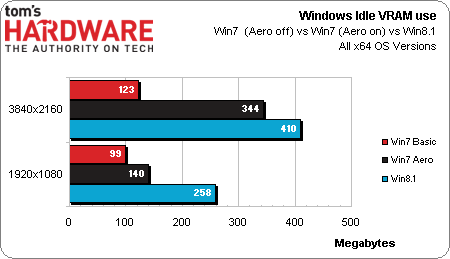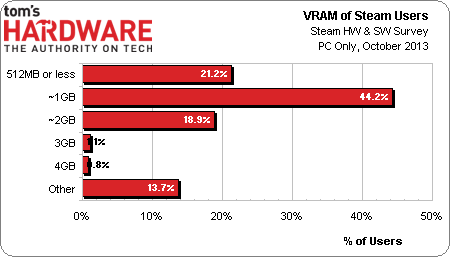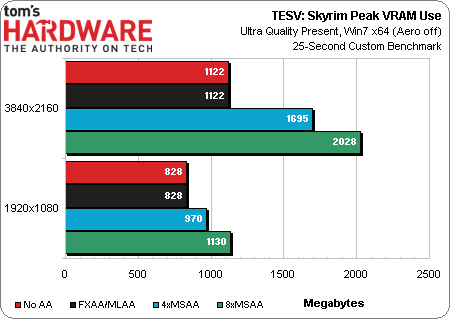Is It Safe to Upload a Picture of the Back of a Graphics Card
The Myths Of Graphics Card Performance: Debunked, Role 1
The Myths Surrounding Graphics Carte du jour Retentiveness
Video memory enables resolution and quality settings, does not improve speed
Graphics memory is ofttimes used by menu vendors as a marketing tool. Because gamers have been conditioned to believe that more is amend, it'southward mutual to see entry-level boards with far more RAM than they need. But enthusiasts know that, as with every subsystem in their PCs, balance is most important.
Broadly, graphics memory is dedicated to a discrete GPU and the workloads information technology operates on, separate from the system memory plugged in to your motherboard. There are a couple of memory technologies used on graphics cards today, the about popular existence DDR3 and GDDR5 SDRAM.
Myth: Graphics cards with two GB of memory are faster than those with 1 GB
Not surprisingly, vendors arm inexpensive cards with too much memory (and eke out college margins) because there are folks who believe more retentivity makes their card faster. Let's set the tape straight on that. The memory capacity a graphics card ships with has no impact on that product's performance, and then long as the settings y'all're using to game with don't swallow all of it.
What does having more video retentiveness actually help, and then? In order to answer that, we need to know what graphics memory is used for. This is simplifying a bit, simply information technology helps with:
- Loading textures
- Holding the frame buffer
- Holding the depth buffer ("Z Buffer")
- Holding other assets that are required to render a frame (shadow maps, etc.)
Of grade, the size of the textures getting loaded into memory depends on the game you lot're playing and its quality preset. As an example, the Skyrim loftier-resolution texture pack includes 3 GB of textures. Most applications dynamically load and unload textures as they're needed, though, so not all textures need to reside in graphics memory. The textures required to return a particular scene do need to be in memory, nevertheless.
The frame buffer is used to shop the image every bit information technology is rendered, before or during the fourth dimension it is sent to the brandish. Thus, its memory footprint depends on the output resolution (an prototype at at 1920x1080x32 bpp is ~8.3 MB; a 4K image at 3840x2160x32 is ~33.two MB), the number of buffers (at to the lowest degree two; rarely 3 or more).
As specific anti-aliasing modes (FSAA, MSAA, CSAA, CFAA, merely non FXAA or MLAA) effectively increase the number of pixels that demand to be rendered, they proportionally increment overall required graphics memory. Render-based anti-aliasing in item has a massive touch on on memory usage, and that grows as sample size (2x, 4x, 8x, etc) increases. Additional buffers also occupy graphics memory.
And then, a graphics card with more memory allows you to:
- Play at college resolutions
- Play at higher texture quality settings
- Play with college return-based antialiasing settings
Now, to address the myth.
Myth: Y'all need i, 2, 3, 4, or 6 GB of graphics memory to play at (insert your brandish's native resolution here).
The well-nigh important factor affecting the amount of graphics retention you need is the resolution you game at. Naturally, higher resolutions require more retentivity. The 2d most important factor is whether y'all're using one of the anti-aliasing technologies mentioned above. Bold a abiding quality preset in your favorite game, other factors are less influential.
Before we move on to the actual measurements, let me to express ane more discussion of caution. There is a particular type of high-end card with two GPUs (AMD's Radeon Hard disk drive 6990 and 7990, along with Nvidia's GeForce GTX 590 and 690) that are equipped with a certain amount of on-board memory. But as a result of their dual-GPU designs, information is essentially duplicated, halving the effective memory. A GeForce GTX 690 with 4 GB, for instance, behaves like ii 2 GB cards in SLI. Moreover, when yous add a second carte to your gaming configuration in CrossFire or SLI, the array's graphics memory doesn't double. Each card still has access only to its own retentiveness.

These tests were run on a Windows 7 x64 setup with Aero disabled. If you're using Aero (or Windows eight/8.i, which doesn't have Aero), yous should add ~300 MB to each and every individual measure y'all run across listed below.

As you tin see from the latest Steam hardware survey, nigh gamers (well-nigh half) tend to own video cards with 1 GB of graphics retentivity, ~xx% accept nigh 2 GB, and the number of users with three GB or more is less than 2%.

Nosotros tested Skyrim with the official loftier-resolution texture pack enabled. Equally you can see, 1 GB of graphics memory is barely plenty to play the game at 1080p without AA or with MLAA/FXAA enabled. Two gigabytes will let you run at 1920x1080 with details cranked up and 2160p with reduced levels of AA. To enable the total Ultra preset and 8xMSAA, non even 2 GB carte is sufficient.
Bethesda's Creation Engine is a unique animate being in this fix of benchmarks. It is not easily GPU-bound, and is instead often limited by platform performance. Merely in these tests, we newly demonstrate how Skyrim tin exist bottlenecked by graphics memory at the highest-quality settings.
It's also worth noting that enabling FXAA uses no memory whatever. In that location'southward a value trade-off to be made in cases where MSAA is non an selection.
stackhousewassittelly.blogspot.com
Source: https://www.tomshardware.com/reviews/graphics-card-myths,3694-5.html
Post a Comment for "Is It Safe to Upload a Picture of the Back of a Graphics Card"